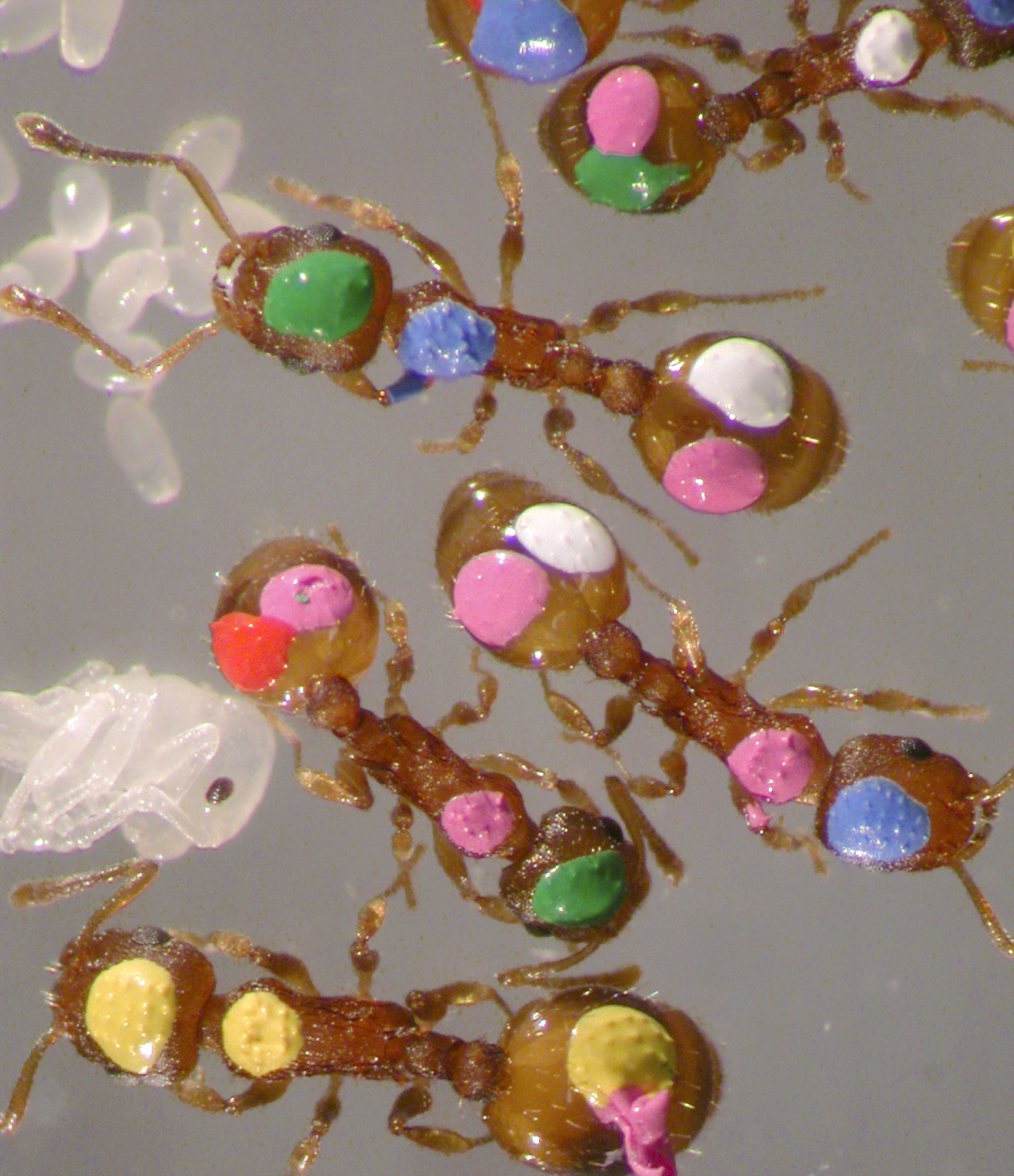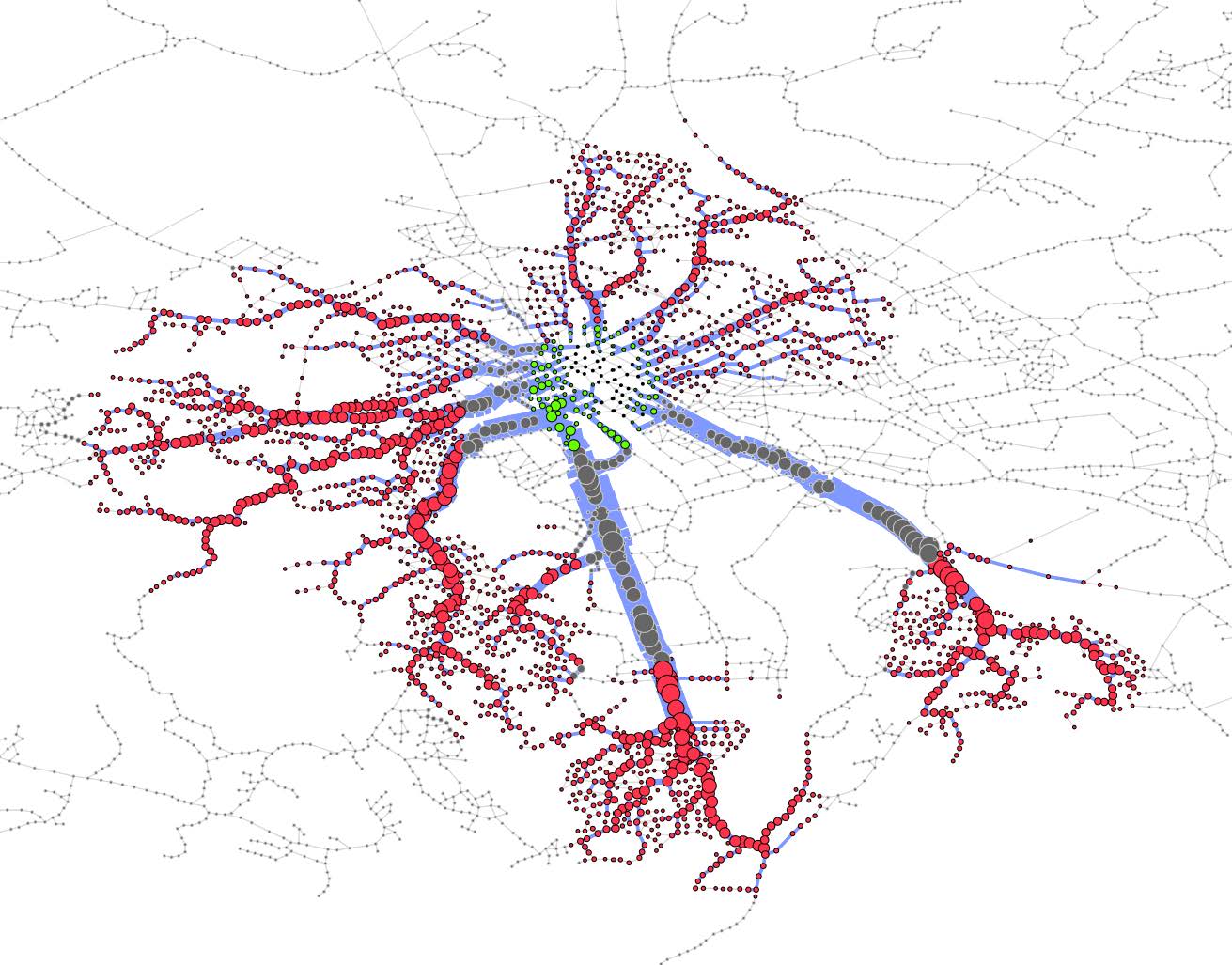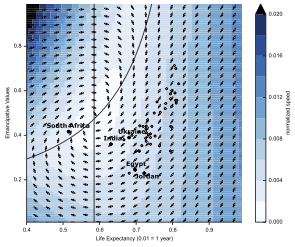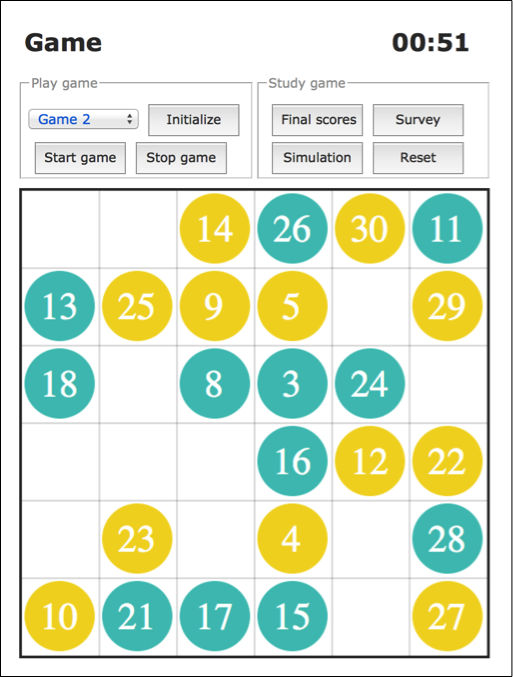Collective Animal Behaviour
 Fish schools, ant trails and bird flocks provide good examples of collective animal behaviour (Sumpter, 2010; Sumpter 2006). How do individuals interact to produce these dynamic patterns? Our research starts by looking at features of moving locust swarms (Buhl et al. 2006; Yates et al. 2009; Dublon & Sumpter 2014), bird flocks (Biro et al. 2006; King & Sumpter, 2012), ant trails (Beekman et al. 2001; Dussutour al. 2009; Reid et al. 2011) and fish schools (Sumpter et al. 2008; Ward et al., 2008; Ward et al, 2011). For example, we studied how a fish school can rapidly turn away from a predator attack (Herbert-Read et al., 2015). In another study we studied how sheepdogs round up large flocks of sheep (Strömbom et al., 2014).
Fish schools, ant trails and bird flocks provide good examples of collective animal behaviour (Sumpter, 2010; Sumpter 2006). How do individuals interact to produce these dynamic patterns? Our research starts by looking at features of moving locust swarms (Buhl et al. 2006; Yates et al. 2009; Dublon & Sumpter 2014), bird flocks (Biro et al. 2006; King & Sumpter, 2012), ant trails (Beekman et al. 2001; Dussutour al. 2009; Reid et al. 2011) and fish schools (Sumpter et al. 2008; Ward et al., 2008; Ward et al, 2011). For example, we studied how a fish school can rapidly turn away from a predator attack (Herbert-Read et al., 2015). In another study we studied how sheepdogs round up large flocks of sheep (Strömbom et al., 2014).
 A focus has been on detailed individual interactions between animals in moving groups. We are developing methods for quantifying these interactions (Sumpter et al 2012a), and have employed these methods on fish (Herbert-Read et al. 2011; Mann et al. 2013a), ants (Perna et al., 2012), prawns (Mann et al. 2013b) and pigeons (Petit et al. 2013). In Temnothorax ants, we have studied the mechanisms they use to choose a new home (Sasaki et al. 2013; Pratt & Sumpter 2006; Pratt et al. 2005). For fish we have created models of movement that are so accurate that they pass a Turing test, where observers can’t distinguish our simulations from real fish movements (Herbert-Read, 2015).
A focus has been on detailed individual interactions between animals in moving groups. We are developing methods for quantifying these interactions (Sumpter et al 2012a), and have employed these methods on fish (Herbert-Read et al. 2011; Mann et al. 2013a), ants (Perna et al., 2012), prawns (Mann et al. 2013b) and pigeons (Petit et al. 2013). In Temnothorax ants, we have studied the mechanisms they use to choose a new home (Sasaki et al. 2013; Pratt & Sumpter 2006; Pratt et al. 2005). For fish we have created models of movement that are so accurate that they pass a Turing test, where observers can’t distinguish our simulations from real fish movements (Herbert-Read, 2015).
Our current research, in a large project funding by the Wallenberg foundation, looks at the connection between social behaviour and the brain. We are artificially selecting social lines of guppies (Szorkovszky et al. 2017) and testing how evolution has shaped their social interactions (Herbert-Read et al. 2017)
 As well as working with experimentalists we develop models to explain general properties of collective behaviour. For example, ant trails can be modelled using a form of current reinforced random walks (Ma et al. 2013). We have also looked at how minimal models can generate complex collective motion (Strömbom 2011). Another unifying theme is the use of quorum thresholds, whereby individuals wait until a threshold number of others have committed to an option before they themselves commit to it (Sumpter & Pratt 2009; Sumpter et al. 2012b). We have used models like these to study different aspects of decision-making (Nicolis et al. 2011; Zabzina et al, 2015).
As well as working with experimentalists we develop models to explain general properties of collective behaviour. For example, ant trails can be modelled using a form of current reinforced random walks (Ma et al. 2013). We have also looked at how minimal models can generate complex collective motion (Strömbom 2011). Another unifying theme is the use of quorum thresholds, whereby individuals wait until a threshold number of others have committed to an option before they themselves commit to it (Sumpter & Pratt 2009; Sumpter et al. 2012b). We have used models like these to study different aspects of decision-making (Nicolis et al. 2011; Zabzina et al, 2015).
Human Social Dynamics
 Our aim is to exploit the rich new socio-economic data sets to help policy-makers. We have developed a set of tools for tracking and understanding social change both at the macro (Ranganathan et al., 2014) and the micro level (Spaiser & Sumpter, 2015), For example, we have studied interactions between the values of the world’s citizens, democracy and development (Spaiser et al, 2014) and tried to understand why some countries get caught in development traps (Ranganathan et al., 2015). Other work looks more directly at socio-economic development in terms of health, education (Ranganathan, preprint) and sustainability (Spaiser et. al., 2017). Although grounded in rigorous research, our aim is to contribute directly to the debate about how to make the world a better place (Sumpter et al., 2015).
Our aim is to exploit the rich new socio-economic data sets to help policy-makers. We have developed a set of tools for tracking and understanding social change both at the macro (Ranganathan et al., 2014) and the micro level (Spaiser & Sumpter, 2015), For example, we have studied interactions between the values of the world’s citizens, democracy and development (Spaiser et al, 2014) and tried to understand why some countries get caught in development traps (Ranganathan et al., 2015). Other work looks more directly at socio-economic development in terms of health, education (Ranganathan, preprint) and sustainability (Spaiser et. al., 2017). Although grounded in rigorous research, our aim is to contribute directly to the debate about how to make the world a better place (Sumpter et al., 2015).
The methods we apply are not limited to big global problems. We have investigated the mechanisms behind school segregation (Spaiser et al., 2015) and have worked together with the Swedish Local Authorities on children’s mental health. We also work on epidemiology in Africa (Nannyonga et al. 2012, 2017), dynamics of the stock market (Nicolis & Sumpter 2011) and of decision-making in the European Union (Saam & Sumpter 2008). At present, my PhD student, Björn Blomqvist, is now looking at how Gaussian processes can be used to better understand causal mechanisms in social systems. His focus is on the rise of the far-right and the (lack-of) relationship between crime and immigration in Sweden.
 Several of our studies have looked at the details of how humans interact with each other. For example, we have studied gaze-following (Gallup et al., 2012), audience applause (Mann et al., 2013), wisdom of the crowds (Granovskiy et al., 2015) and mosh pits (Bottinelli et al., 2016). In a project together with Milena Tsetkova, we developed a new form of experimental game setup, where up to 30 individuals can simultaneously interact using a tablet and a shared screed. We used this in Swedish classrooms to study segregation processes (Tsvetkova et. al., 2016).
Several of our studies have looked at the details of how humans interact with each other. For example, we have studied gaze-following (Gallup et al., 2012), audience applause (Mann et al., 2013), wisdom of the crowds (Granovskiy et al., 2015) and mosh pits (Bottinelli et al., 2016). In a project together with Milena Tsetkova, we developed a new form of experimental game setup, where up to 30 individuals can simultaneously interact using a tablet and a shared screed. We used this in Swedish classrooms to study segregation processes (Tsvetkova et. al., 2016).
Evolutionary and population dynamics
We investigate how ecological interactions between individuals produce population dynamics. We have looked at how different forms of competition lead to chaotic oscillations in species numbers (Bränström & Sumpter, 2005a) and the role of space in ecology (Bränström & Sumpter, 2005b). Other work looks at the evolution of co-operation (Cornforth et al. 2012). I am currently working on these models together with my PhD student, Linnea Gyllingberg.
Another student Yu Liu (Ernest) has recently completed his thesis investigating more abstract models of the evolution of self-replication (Liu & Sumpter, 2018) and ecosystem dynamics (Liu & Sumpter, 2017). The aim of this work, building on complexity theory, is to investigate the fundamental requirements and constraints on life on this planet and, possibly, elsewhere in the Universe.
Collective behaviour blog
 Our group has adopted an open science approach to research. As well as producing traditional scientific literature we run the collective behaviour webpage, where we apply our expertise in modelling directly and write short articles on ‘hot’ topics. We have modelled gender discrimination in science, popularity of songs and scientific papers. For our animal behaviour research we have written a beat the ants game, a spot the real and modelled fish test and soundalizing cicada data. We also give straightforward accounts of our research on value change, democracy, micro-finance and development. We have made videos outlining our approach and methods. Now and again we do something which is just pure fun, like modelling dating or trying to think up ways of making a collective dance show.
Our group has adopted an open science approach to research. As well as producing traditional scientific literature we run the collective behaviour webpage, where we apply our expertise in modelling directly and write short articles on ‘hot’ topics. We have modelled gender discrimination in science, popularity of songs and scientific papers. For our animal behaviour research we have written a beat the ants game, a spot the real and modelled fish test and soundalizing cicada data. We also give straightforward accounts of our research on value change, democracy, micro-finance and development. We have made videos outlining our approach and methods. Now and again we do something which is just pure fun, like modelling dating or trying to think up ways of making a collective dance show.